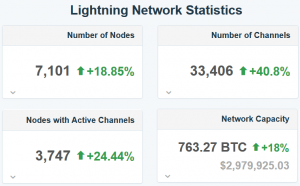The Lightning Network: Challenges and Solutions
In the case of Lightning, some centralization will probably occur. But as soon as the centralization starts becoming harmful, it should be easy to fix.

The Lightning Network (LN) seems to be on the up. New applications for Bitcoin’s second-layer scaling solution are constantly appearing, while even big companies like Twitter are flirting with the idea of using Lightning-aided Bitcoin payments.
However, while the Lightning Network has made considerable progress since its white paper was published in January 2016, it still has some way to go. Not only does it still suffer from a limited number of developers, but there are number of fundamental questions regarding its economics, centralization and scalability.
Centralization and economics
The Lightning Network may promise greater scalability for Bitcoin. But there’s a tradeoff: centralization, as underlined by Bitcoin expert and security researcher Tony Arcieri.
“Lightning’s architecture inherently favors economies of scale, leading many to suspect it would naturally converge in a small set of well-connected “hubs” which will route the overwhelming majority of payments,” he tells Cryptonews.com, “and so far it appears Lightning ‘hubs’ naturally arise from the economic and technical requirements of the network.”
The reason why the Lightning Network favors economies of scale is that fees have to be paid in order to open an LN channel. This may prove costly for individuals wanting to process single payments, while large companies will be able to afford (and profit from) having multiple channels open at once.
Put differently, the responsibility for handling large numbers of transactions will end up with only a few big entities. But while this is a possibility, supporters of the Lightning Network argue that it can be defended against.
“It’s very hard to avoid centralization by economies of scale. For instance, Bitcoin’s mining has similar issues,” says Corné Plooy, a Lightning Network developer.
“In the case of Lightning, some centralization will probably occur, but as soon as the centralization starts becoming harmful, it should be easy to set up new channels to route around the central party. “
“Harmful network effects (‘everyone else is on <evil node>, so I have to be on <evil node> as well’) can be prevented by setting the right technical standards right from the start. A high level of privacy helps: it means a central node can’t detect and can’t prevent the establishment of gateways to more free parts of the network, so that a smooth transition away from centralization remains possible.”
User experience and development
For a protocol that’s supposed to make Bitcoin more usable if it were ever adopted on a large scale, the UX offered by the Lightning Network still leaves something to be desired.
“The lack of polished user experiences has limited the reach of the Lightning Network in the past, and its wider consumer adoption, being perceived as a complicated technology that is accessible to tech-savvy users,” says Christian Decker, core tech engineer at Blockstream, which is an important contributor to the Lightning Network.
“To tackle these issues we are trying to make Lightning itself more accessible with more advanced features that allow to hide some of the complexity behind better abstractions, and at the same time helping new developers find their way in the Lightning specification and implementations.”
Companies such as Blockstream and Lightning Labs (the principal developers of the LN) are working hard to improve the Network’s interface, yet Decker affirms that enhancements are being slowed down at the moment by a relative shortage of developers.
“However the limited number of developers that can contribute to the protocol, implementations and applications on top of the implementations have been limiting the speed at which we can develop the technology.”
And will it actually scale?
And even though the protocol is meant to provide greater scalability, there are still questions as to whether the Lightning Network will actually scale to a sufficiently high level.
“Lightning is often described (and modeled in simulations) as a limitlessly scalable network much like the Internet where interconnected nodes can scale independent of the performance bottleneck of the Bitcoin blockchain,” explains Tony Arcieri. “However, the Internet’s seemingly limitless scalability only works because it doesn’t have a central point of contention.”
According to Arcieri, systems with central points of contention (i.e. contention for computing resources) are well-studied in computer science, with Amdahl’s Law stating that the scalability of such systems “is significantly less than what we might intuitively expect.”
That said, Corné Plooy isn’t particularly moved by this argument.
“If the mentioned ‘central points of contention’ only occur in a centralized network, so that only a ‘centralized’ Lightning network would scale poorly, that would be a good thing,” he says, “it would be a counter-force against economies of scale.”
As he concludes, the poorer the scalability of a centralized Lightning network, the more decentralized the Lightning network will remain.
Strong beginnings
The Lightning Network may have big challenges to resolve. Still, it has already made encouraging progress, despite the fact that its beta went live only in March 2018.
“The Lightning Network has seen an incredible adoption over the last year, that has exceeded our expectations,” says Christian Decker, who adds that the Blockstream Store – which runs on the LN – has processed over 1,800 transactions since its January 2018 launch.
“The feedback has been overwhelmingly positive and the community has grown quickly alongside the implementations. We are very happy with how helpful and inclusive the community is, helping onboard new users, sharing their insights with the developer teams, and pushing novel use-cases that we could not have foreseen.”
_____

_____
Listen to this Epicenter Podcast where Christian Decker talks about the current state of the Lightning network, its vision and other topics:




